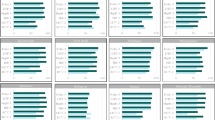Abstract
Objective: Main objectives were to assess the feasibility of linking vitamin A delivery with National Immunization Days (NIDs) and to see the impact on xerophthalmia.Methods: An Intervention study of mass distribution of vitamin A solution was undertaken to control widespread xerophthalmia prevalent in children living in about 26 slums of Chandigarh in the year 2000. Two rounds of mass distribution of Vitamin A solution covering 27642 and 31762 children in 1–5 years of age in first and second rounds, respectively, were undertaken. The findings of second round and post evaluation after intervention are presented here. An additional team of two persons per pulse polio immunization (PPI) centre delivered age specific doses of vitamin A solution through 98 centres and operational problems were recorded. PPI staff provided the supervision and PPI tally sheets were used.Results: The programme achieved a vitamin A coverage rate of 99% in first round and 88% in second round. Only two parents refused vitamin A solution. No side effect or cases of toxicity due to vitamin A were reported by health institutions in the area or in a stratified random sample of 101 children. There was a significant decline (13.4%) in xerophthalmia after two rounds of mass distribution (P < .001). The strategy to deliver vitamin A was successfully integrated into NID’s and appeared to achieve a significant decline in xerophthalmia.Conclusion: Linking of vitamin A distribution with PPI could be a basis for launching similar initiatives in other areas of India and other countries where xerophthalmia is a public health problem.
Similar content being viewed by others
References
WHO.Global Programme for Vaccines and Immunization-Using NID to deliver vitamin A. EPI update 33, 1998.
National Nutrition Monitoring Bureau, Annual Report, 1991. Hyderabad, National Institute of Nutrition, 1991.
Rahmathullah L, Underwood BA, Thulsiraj RDet al. Reduced mortality among children in India receiving a small weekly dose of vitamin A.New Eng J Med 1990; 323:929–935.
Vijayaraghavan K, Radhaiah G, Prakasan BSet al. Effect of massive dose of vitamin A on morbidity and mortality in Indian children.Lancet 1990; 336:1342–1345.
WHO.Global prevalence of vitamin A deficiency: MDIS working paper # 2. WHO: Geneva, 1995.
Beaton GH. Effectiveness of vitamin A supplementation in the control of young child morbidity and mortality in developing countries. New York; United Nations Administrative Committee on CoordinationJSubcommittee on Nutrition, 1993 (ACCJSCN State of the Art Series, Nutrition Policy Discussion paper number 31).
Sommer A, West KP Jr. Vitamin A Deficiency: Health, Survival and Vision. New York; Oxford University Press, 1996.
Integration of vitamin A supplementation with immunization.WHO Weekly Epidemiohgical Report 1999; 74:1–8.
Swami HM, Thakur JS, Bhatia SPS, Ahuja R. Rapid assessment and delivery of vitamin A to slum children by using National Immunization Day in Chandigarh.Indian J Pediatr 2001; 68:719–723.
Sommer A. Xerophthalmia: Clinical classification and diagnosis. InVitamin A Deficiency and its Consequences-A field guide to detection and control. 3rd edn. Geneva, WHO 1995 : 8–13.
Swami HM, Thakur JS, Bhatia SPS, Singh K, Bhan VK, Bhatia V. National Immunization Day to assess nutritional status of underfives in Chandigarh.Indian J Pediatr 2000; 67^(1): 15–17.
Miller DR, Hayes KC. “Vitamin excess and toxicity.” In Hathcock JN, ed.Nutritional Toxicology Vol. 1, New York; Academic Press, 1982; 81–133.
Khamgaonakar MBet al. Vitamin A intake and vitamin A deficiency in rural children.Indian Pediatr 1990; 27:443–446.
Singh MC, Gagane N, Murthi GVet al. Evaluation of vitamin A status by conjuctival impression cytology among school age population.Indian Pediatr 1993; 30:1085–1089.
Bellamy C. Nutrition Indicators. InThe State of the World Children 2000. UNICEF, 2000; 88–91.
Swami HM, Bhatia V, Bhatia SPS, Singh K, Kaur M, Kaur A. Existing MCH services in rural area of Chandigarh.Indian J Community Medicine 1997; 22:110–113.
Author information
Authors and Affiliations
Corresponding author
Rights and permissions
About this article
Cite this article
Swami, H.M., Thakur, J.S. & Bhatia, S.P.S. Mass supplementation of Vitamin A linked to National Immunization Day. Indian J Pediatr 69, 675–678 (2002). https://doi.org/10.1007/BF02722703
Issue Date:
DOI: https://doi.org/10.1007/BF02722703




